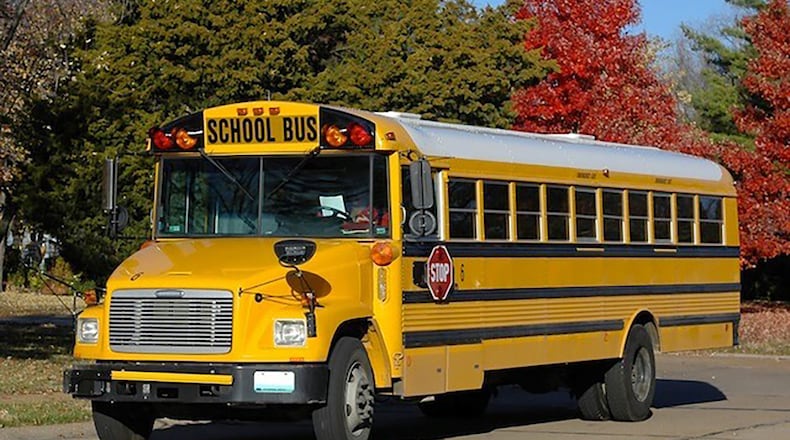“And then with COVID, we have quite a few people out on sick leave for many different reasons, so it’s on everybody’s minds right now,” Silverthorn said.
In Fairborn, the school district had several drivers test positive for the coronavirus the week of Oct. 12. Those drivers and additional drivers they had been in close contact with had to quarantine, causing the district to not have enough drivers to get kids to school. Parents and guardians had to take their kids to school one day, and school was held remotely another day the same week.
Two days later on Oct. 14, the district posted on its Facebook page that a number of bus drivers were quarantining due to being exposed to the coronavirus. This left the district without enough drivers to serve all bus routes. The district encouraged all families to have a back-up plan to get their children to school. Bus drivers did take students home that day.
Fairborn schools could not be reached for comment on whether bus drivers were still quarantining.
Silverthorn said in Kettering, there has been minimal exposure to COVID in the transportation department. Most students have not returned to in-person classes yet, but some staff are out on sick leave per their doctors' request because they are at high risk, he said.
“I have heard in some other districts their staff has to quarantine. If you take out two, three or four drivers in a week, that’s 14 days you have to quarantine those people to ensure safety of students and staff, and that’s a huge impact, especially when you’re as short as what we are on driving staff,” Silverthorn said.
Before the pandemic, Kettering had about 12 substitute drivers in training, but when everything shut down, the district lost many of those people.
“I think we are needing more than some of the other districts around right now,” Silverthorn said. “The need is real. Every school district is in need."
Silverthorn said if a district gets to the point where they can’t cover bus routes, they look at sending kids to school later, doubling up on routes or contracting out with a privatized company to get substitute bus drivers. Silverthorn said school districts could also look at expanding the radius of how far away students need to live from school to get busing to their area.
“It’s a hard call, because at that point you’re now inconveniencing the families because they have jobs they have to get to and they’re depending on that transportation to school,” Silverthorn said.
According to a survey from the National Association for Pupil Transportation from 2017, the main factors that make it difficult to recruit and retain bus drivers are the hours a bus driver works, the rate of pay, the benefits and the training needed for the job.
Evette Moody, a pre-service bus driving instructor for the western region of Ohio, said driving a school bus is a part-time job with a full-time responsibility. Moody trains bus drivers for the Ohio Department of Education. Bus drivers in Ohio need to have 15 hours of classroom training and at least 12 hours of training behind the wheel.
“It’s a lot of responsibility to drive a big vehicle with students on board,” Moody said.
Bus drivers need to get their Commercial Driver’s License (CDL) before working. Bus drivers work a split shift, Silverthorn said, which can be difficult for some people. It is also a part-time job, so there are not always health benefits, he said.
Because of these factors, Silverthorn said he doesn’t see the bus driver shortage getting better anytime soon.
“It’s not an easy job, but it’s a very rewarding job,” Moody said. “A lot of people do stick with it. They get other jobs in the district or get a summer job so that they can drive during the school year.”
Moody started as a bus driver for Beavercreek schools.
Moody said most school districts in the country would probably say they are experiencing a “slight to severe” shortage. Moody said other driving trades, like truck drivers, are also seeing this trend.
“This is an ongoing shortage,” Moody said. “We had it before the pandemic and we will have it after. The shortage doesn’t have to do with COVID, it has to do with the type of work that it is."
About 40% of respondents to that National Association for Pupil Transportation survey said they’re experiencing a moderate bus driver shortage, which is a shortage of about 6% or 10%. Ten percent of respondents said their shortage is “desperate,” or more than 16% short, the data said.
The majority of people who responded to this survey were transportation managers or bus fleet managers, according to the survey.
Silverthorn said Kettering is currently looking to find 16 substitute drivers and to fill six open bus route positions.
Kettering has 70 bus routes to cover this year, Silverthorn said. The district has to keep substitute staff levels high enough to cover any call-offs or sick leave as well as covering for bus aides too. Some smaller districts may not have substitutes that come in daily, but use a pool of five to 10 substitutes who are on call and may be working for a different district that day, he said.
About the Author

